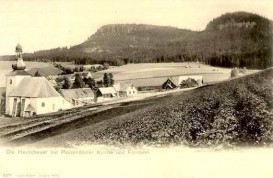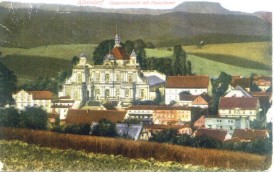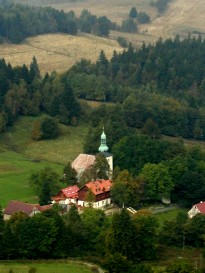Góry Stołowe - kraina zrodzona z morza
 Tourism
Tourism
The settlement in the Stolowe Mountains
The National Park territory and its surroundings as much as the whole Kłodzko Region is a land of three nations. This is commemorated by the monument unveiled in 1999 in Kudowa Czermna dedicated to Czechs, Polish and Germans, who contributed to the settlement and development of this land. In the antiquity, some important communication routes ran through the Kłodzko Region, linking the Czech Valley with the basin of the Oder river. One of them, a branch of the "amber route", passed by the southern foot of the Stołowe Mountains and then through the pass of Polish Gate (Polskie Wrota). The second one, which was established much later, linked Kłodzko with Broumov via Radków. The first settlements, undoubtedly Slavic, developed along those trading routes, and to their defence the medieval cities Homole, Ratno and Radków were built. Written records about villages lying at the edge of the Stołowe Mountains and in The Lewin Hills come from the 14th century, although they must have existed already in the 13th century. In these early Middle Ages the Kłodzko Region stayed under the Czech reign, although as a border territory it often came under the reign of Silesian Piasts. In the second half of the 13th century slowly began the process of germanization of the Kłodzko Region associated with the colonization based on German law. However, in the territory of the Stołowe Mountains and Lewin Hills, the Slavic element still lasted to the end of II World War. The proof of this is not only the Czech language remaining here but also the Slavic names of places: Lewin, Czermna or Bukowina, not changed into German-sounding names until 1933. The border region in the vicinity of Kudowa was described in German literature as "the Czech nook". The Homole stronghold, which in 14th century was a powerful centre of reign, led to the rise of an independent feudal "Homole state" in the today's Park territory and its surroundings. It lasted till the destruction of the castle during the hussite wars which struck the Kłodzko region in the first half of the 15th century. In 1459 the Czech king George of Podiebrad established an independent Kłodzko county, in which the territories of the former Homole state were later incorporated. After the liquidation of the latter, after 1561 under the emperor's Charles VI order, the then-existing roads crossing Stołowe Mountains woods were rebuilt: the Prague Route and Kręgielny Route running parallel to it. The latter is today a local asphalt road from Batorów to Karłów. Both routes were the important links between the Lower Silesia and Czech. They had lost their importance after the Way of Hundred Turns was built in the second half of the 19th century. The Prague Route with its extension Machowska Way running from Karłów to Czech via Ostra Góra was aconvenient post route for a long time. Evidence for this are milestones preserved until today, showing distances between the places of rest. The Kłodzko County retained some autonomy for centuries within the Habsburg monarchy under the reign of which it passed in 1526, and also later within the Prussian monarchy. From the end of the 16th century and beginning of the 17th century come the first records about mineral waters of Kudowa and Duszniki. Then, these health resorts started their curative activities. Their development and international fame contributed to the prosperity of the whole region, attracting patients and tourists through the next centuries. In the first half of the 17th century, the Kłodzko Region was struck by the Thirty Years' War (1618-1648), which brought about a great devastation. After its end, linen and cotton weaving developed in the Kłodzko Region prviding for most of villagers in the region of the Stołowe Mountains and Lewin Hills in the 17th and also in the following centuries. Poor harvests on meagre mountain soils and overpopulation of the villages both enforced the devolopment of trade and local craftsmanship. In the 18th century after the takeover of Silesia by Prussia, so called three Silesian Wars took place in the Kłodzko Region.
Region associated with the colonization based on German law. However, in the territory of the Stołowe Mountains and Lewin Hills, the Slavic element still lasted to the end of II World War. The proof of this is not only the Czech language remaining here but also the Slavic names of places: Lewin, Czermna or Bukowina, not changed into German-sounding names until 1933. The border region in the vicinity of Kudowa was described in German literature as "the Czech nook". The Homole stronghold, which in 14th century was a powerful centre of reign, led to the rise of an independent feudal "Homole state" in the today's Park territory and its surroundings. It lasted till the destruction of the castle during the hussite wars which struck the Kłodzko region in the first half of the 15th century. In 1459 the Czech king George of Podiebrad established an independent Kłodzko county, in which the territories of the former Homole state were later incorporated. After the liquidation of the latter, after 1561 under the emperor's Charles VI order, the then-existing roads crossing Stołowe Mountains woods were rebuilt: the Prague Route and Kręgielny Route running parallel to it. The latter is today a local asphalt road from Batorów to Karłów. Both routes were the important links between the Lower Silesia and Czech. They had lost their importance after the Way of Hundred Turns was built in the second half of the 19th century. The Prague Route with its extension Machowska Way running from Karłów to Czech via Ostra Góra was aconvenient post route for a long time. Evidence for this are milestones preserved until today, showing distances between the places of rest. The Kłodzko County retained some autonomy for centuries within the Habsburg monarchy under the reign of which it passed in 1526, and also later within the Prussian monarchy. From the end of the 16th century and beginning of the 17th century come the first records about mineral waters of Kudowa and Duszniki. Then, these health resorts started their curative activities. Their development and international fame contributed to the prosperity of the whole region, attracting patients and tourists through the next centuries. In the first half of the 17th century, the Kłodzko Region was struck by the Thirty Years' War (1618-1648), which brought about a great devastation. After its end, linen and cotton weaving developed in the Kłodzko Region prviding for most of villagers in the region of the Stołowe Mountains and Lewin Hills in the 17th and also in the following centuries. Poor harvests on meagre mountain soils and overpopulation of the villages both enforced the devolopment of trade and local craftsmanship. In the 18th century after the takeover of Silesia by Prussia, so called three Silesian Wars took place in the Kłodzko Region.  The devastation added to hunger and plagues already striking towns and villages. The memento of such epidemics, mainly from the period of the last (seven years') war is a unique monument - Skull Chapel in Kudowa Czermna. Connected with the Silesian Wars or actually with border disorders after the end of the wars, is the building of Charles's Fort (1790), which remains still can be seen not far from the Fox Pass (Lisia Przełęcz) in the centre of the National Park. The search of a proper place to build a fort by the king of Prussia Frederick II is connected with the story of discovering and rendering accessible the biggest attraction of the Stołowe Mountains - their highest peak Szczeliniec Wielki. The access to Szczeliniec Wielki , boom of health resorts of Kudowa and Duszniki and also functioning of the pilgrimage centre of Virgin Mary cult in Wambierzyce all became basis of tourism development in the region from the end of the 18th century. It assumed a mass character especially after, in the first half of the 19th century, convenient roads were built as well as railway connections between Radków and Ścinawka, and Kudowa and Kłodzko in the beginning of the 20th century. In that time, a number of sanatoria, hotels, baths and pump rooms were built in the health resorts (also in fast developing Polanica). Many other tourist facilities were built such as a shelter- house on Szczeliniec (1845) and inns in Karłówek and Pasterka. The Kłodzko Mountain Society (Kłodzkie Towarzystwo Górskie) existing from 1881 built new passes in the mountains, marked tourist routes and prepared viewpoints. I and II World War did not leave their stamp on the National Park territory and its surroundings. In memory of the war, monuments were placed in the villages on the Polish-Czech borderland, which commemorated those inhabitants who were enlisted into the Prussian army and died in field (Karłów, Kudowa Czermna). Connected with II World War are a labour camp in Kudowa Zakrze, remains of Wehrmacht training camp at the beginning of an entry road to Rocky Errant (Błędne Skały), recently exhumed German soldiers' cemetery at the border of the Park near the road from Kudowa to Jerzykowice Wielkie, and German parson's tombstone, who as a Hitler's enemy was killed in Dachau - it is located in the cemetery in Kudowa Czermna. After II World War in 1945, despite
The devastation added to hunger and plagues already striking towns and villages. The memento of such epidemics, mainly from the period of the last (seven years') war is a unique monument - Skull Chapel in Kudowa Czermna. Connected with the Silesian Wars or actually with border disorders after the end of the wars, is the building of Charles's Fort (1790), which remains still can be seen not far from the Fox Pass (Lisia Przełęcz) in the centre of the National Park. The search of a proper place to build a fort by the king of Prussia Frederick II is connected with the story of discovering and rendering accessible the biggest attraction of the Stołowe Mountains - their highest peak Szczeliniec Wielki. The access to Szczeliniec Wielki , boom of health resorts of Kudowa and Duszniki and also functioning of the pilgrimage centre of Virgin Mary cult in Wambierzyce all became basis of tourism development in the region from the end of the 18th century. It assumed a mass character especially after, in the first half of the 19th century, convenient roads were built as well as railway connections between Radków and Ścinawka, and Kudowa and Kłodzko in the beginning of the 20th century. In that time, a number of sanatoria, hotels, baths and pump rooms were built in the health resorts (also in fast developing Polanica). Many other tourist facilities were built such as a shelter- house on Szczeliniec (1845) and inns in Karłówek and Pasterka. The Kłodzko Mountain Society (Kłodzkie Towarzystwo Górskie) existing from 1881 built new passes in the mountains, marked tourist routes and prepared viewpoints. I and II World War did not leave their stamp on the National Park territory and its surroundings. In memory of the war, monuments were placed in the villages on the Polish-Czech borderland, which commemorated those inhabitants who were enlisted into the Prussian army and died in field (Karłów, Kudowa Czermna). Connected with II World War are a labour camp in Kudowa Zakrze, remains of Wehrmacht training camp at the beginning of an entry road to Rocky Errant (Błędne Skały), recently exhumed German soldiers' cemetery at the border of the Park near the road from Kudowa to Jerzykowice Wielkie, and German parson's tombstone, who as a Hitler's enemy was killed in Dachau - it is located in the cemetery in Kudowa Czermna. After II World War in 1945, despite  the Czech claims, the Kłodzko region was incorporated into Poland. Then an almost complete exchange of population took place. Displaced Germans and Czechs were replaced with inhabitants coming as settlers from the eastern territories formerly belonged to Poland and then incorporated into the Soviet Union. This led to very important changes in the region of the Stołowe Mountains and the Lewin Hills. The newcomers neither had abilities of farming in the difficult mountain conditions, nor were they able to continue the village holiday traditions. This was the reason of the progressing decline of agriculture in this region and depopulation of the mountain villages. Many of them like Ostra Góra, Karłówek, Grodczyn, Leśna entirely disappeared from the face of the earth. The Polish People's Republic expanded the existing tourist-holiday complex based on existing health resorts. However, this resulted in great damage to the environment of these curative places. Industrial plants were built or expanded in the health resorts, accompanied with housing estates that failed to fit in the environment. The intensive exploitation of the existing hotel and holiday base in the Polish People's Republic period caused great devastation leading to a low standard of services. At present the privatisation process goes on, with development of modern hotels and holiday facilities as well as the trade- service base aimed at tourists and holidaymakers. The great attractiveness of the region supports the growth of private hotels, mountain shelters and agro- tourism households not only in the area of health resorts and cities, but also within the villages.
the Czech claims, the Kłodzko region was incorporated into Poland. Then an almost complete exchange of population took place. Displaced Germans and Czechs were replaced with inhabitants coming as settlers from the eastern territories formerly belonged to Poland and then incorporated into the Soviet Union. This led to very important changes in the region of the Stołowe Mountains and the Lewin Hills. The newcomers neither had abilities of farming in the difficult mountain conditions, nor were they able to continue the village holiday traditions. This was the reason of the progressing decline of agriculture in this region and depopulation of the mountain villages. Many of them like Ostra Góra, Karłówek, Grodczyn, Leśna entirely disappeared from the face of the earth. The Polish People's Republic expanded the existing tourist-holiday complex based on existing health resorts. However, this resulted in great damage to the environment of these curative places. Industrial plants were built or expanded in the health resorts, accompanied with housing estates that failed to fit in the environment. The intensive exploitation of the existing hotel and holiday base in the Polish People's Republic period caused great devastation leading to a low standard of services. At present the privatisation process goes on, with development of modern hotels and holiday facilities as well as the trade- service base aimed at tourists and holidaymakers. The great attractiveness of the region supports the growth of private hotels, mountain shelters and agro- tourism households not only in the area of health resorts and cities, but also within the villages.
This is worth seeing!...
- Szczeliniec Wielki
- Błędne Skały
- Skalne Grzyby
- Białe Skały
- Łężyckie Skałki
- Radkowskie Skały i Filary Skalne
- Wodospady Pośny
Do you want to know more? Choose the topic:
Park Narodowy Gór Stołowych
ul. Słoneczna 31
57-350 Kudowa Zdrój
tel. +48 74/ 8661-436, +48 74/ 8662-097
fax. +48 74/ 8654-918
pngs@pngs.com.pl
Copyright by Park Narodowy Gór Stołowych
